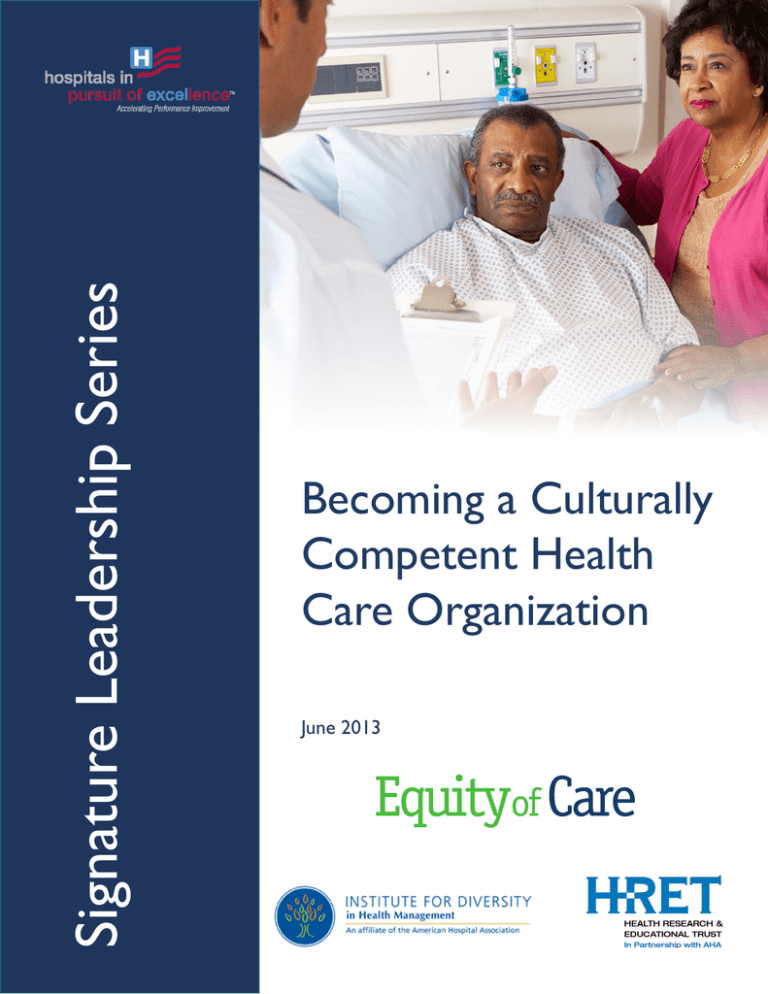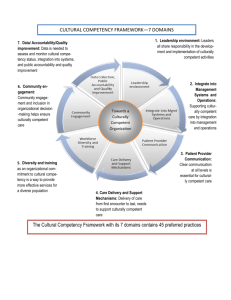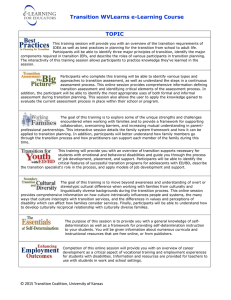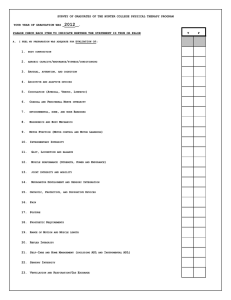
Signature Leadership Series
Becoming a Culturally
Competent Health
Care Organization
June 2013
Resources: For information related to equity of care, visit www.hpoe.org and www.equityofcare.org.
Suggested Citation: Health Research & Educational Trust. (2013, June). Becoming a culturally
competent health care organization. Chicago, IL: Illinois. Health Research & Educational Trust Accessed at
www.hpoe.org.
Accessible at: http://www.hpoe.org/becoming-culturally-competent
Contact: hpoe@aha.org or (877) 243-0027
© 2013 American Hospital Association. All rights reserved. All materials contained in this publication are available
to anyone for download on www.hret.org or www.hpoe.org for personal, noncommercial use only. No part of this
publication may be reproduced and distributed in any form without permission of the publisher, or in the case of
third party materials, the owner of that content, except in the case of brief quotations followed by the above
suggested citation. To request permission to reproduce any of these materials, please email HPOE@aha.org.
1
Becoming a Culturally Competent Health Care Organization
Becoming a Culturally Competent Health Care Organization
Background
This guide is part of a continuing series that will support hospitals and care systems as they work to
reduce health care disparities and promote diversity in health care governance and leadership. Becoming
a culturally competent health care organization is a critical component in reducing health care
disparities. A recent survey by the Institute for Diversity in Health Management, an affiliate of the
American Hospital Association, found that 81 percent of hospitals educate all clinical staff during
orientation about how to address the unique cultural and linguistic factors affecting the care of diverse
patients and communities, and 61 percent of hospitals require all employees to attend diversity training.
This is a positive start, but more work needs to be done in this area.
In 2011, the American College of Healthcare Executives, American Hospital Association, Association of
American Medical Colleges, Catholic Health Association of the United States, and National Association
of Public Hospitals and Health Systems stood together in a call to action to eliminate health care
disparities. Our focus is on increasing the collection of race, ethnicity and language preference data;
increasing cultural competency training; and increasing diversity in governance and leadership.
As national partners, we are committed to these focus areas and will support quality improvement in
health care through shared best practices and resources. Ensuring that all hospitals prepare their
clinicians and staff to meet the care needs of all patients is an important component of an overall effort
to improve equitable care and a goal of the call to action.
2
Becoming a Culturally Competent Health Care Organization
Introduction
Cultural competence in health care describes the ability to provide care to patients with diverse values,
beliefs and behaviors, including tailoring health care delivery to meet patients’ social, cultural and
linguistic needs1. A key component to new care delivery models, such as patient-centered medical
homes and accountable care organizations, is the ability to engage and educate patients about their
health status. While doing this is challenging with all patients, for diverse patient populations it can be
even more difficult due to language barriers, health literacy gap, and cultural differences in
communication styles.
It is imperative that hospitals and health care systems understand not only the diverse patients and
communities they serve but also the benefits of becoming a culturally competent organization. Hospitals
and care systems must prepare their clinicians and staff to interact with patients of diverse
backgrounds to increase patient engagement and education and to help eliminate racial and ethnic
disparities in care. To improve understanding of diverse cultures, hospitals and care systems should seek
advice from individuals and groups in the communities they serve. These constituencies can help
hospitals and care systems develop educational materials, increase patient access to services and
improve health care literacy.
In 2013, the Office of Minority Health, U.S. Department of Health and Human Services, issued enhanced
National Culturally and Linguistically Appropriate Services (CLAS) Standards in Health and Health Care,
and a blueprint with guidance and strategies to help implement them. This first update to the standards
since their initial release in 2000 expands upon the concepts of culture to reflect new developments
and trends, and focuses on leadership and governance as drivers of culturally competent health care and
health care equity2. More information on CLAS Standards is available at the end of this guide.
Benefits of Cultural Competence
Cultural competence in a hospital or care system produces numerous benefits for the organization,
patients and community. Organizations that are culturally competent have improved health outcomes,
increased respect and mutual understanding from patients, and increased participation from the local
community3. Additionally, organizations that are culturally competent may have lower costs and fewer
care disparities4.
Figure 1. Benefits of Becoming a Culturally Competent Health Care Organization
Social Benefits
Health Benefits
Business Benefits
• Increases mutual respect and
understanding between patient
and organization
• Increases trust
• Promotes inclusion of all
community members
• Increases community
participation and involvement in
health issues
• Assists patients and families in
their care
• Promotes patient and family
responsibilities for health
• Improves patient data collection
• Increases preventive care by
patients
• Reduces care disparities in the
patient population
• Increases cost savings from a
reduction in medical errors,
number of treatments and legal
costs
• Reduces the number of missed
medical visits
• Incorporates different
perspectives, ideas and strategies
into the decision-making process
• Decreases barriers that slow
progress
• Moves toward meeting legal and
regulatory guidelines
• Improves efficiency of care
services
• Increases the market share of the
organization
Source: American Hospital Association, 2013.
3
Becoming a Culturally Competent Health Care Organization
Steps to Becoming a Culturally Competent Organization
Before a health care organization becomes culturally competent, leaders must understand the local
community and the role the organization plays within the community. Steps to becoming culturally
competent include (1) analyzing data and microtargeting surveys to improve service for the local
community, (2) communicating survey findings to determine priorities and (3) educating staff and
aligning programming and resources to meet community needs. Figure 2 highlights the process involved
for a health care organization to become culturally competent.
Figure 2. Becoming a Culturally Competent Health Care Organization
Community Survey
The hospital or health care
system analyzes demographic
data to determine the
composition of the local
community and the hospital's
patient population. With this
analysis, the hospital or care
system can conduct
microtargeting surveys to
determine needs for the
specific communities.
Community Engagement
Staff Education
The hospital or health care
system communicates survey
findings to community
members and determines
priorities. This information
serves as the basis for staff
education.
Working with community
feedback and survey data, the
hospital or care system
educates staff on the
importance of cultural
competence and the particular
cultural needs of patients that
staff interact with each day.
Source: American Hospital Association, 2013.
Educational Principles for Cultural Competence
Becoming a culturally competent organization requires a thorough understanding of the principles that
characterize cultural competence (see Figure 3). First, staff needs to understand the factors that are
pushing hospitals and care systems to become culturally competent. Hospital staff also needs to
recognize and understand the cultural and clinical dynamics in interactions with patients. Becoming
culturally competent involves developing and acquiring the skills needed to identify and assist patients
from diverse cultures. With the necessary skills and mindset, staff can quickly identify the services
required by a patient, thereby increasing positive health outcomes.
4
Becoming a Culturally Competent Health Care Organization
Figure 3. Educational Principles for Cultural Competence
• Explain the changing population
of the United States
• Describe the demographics of
the hospital's patient population
• Examine the health disparity
data
Background
Effect of Cultural
Influences/Clinical
Encounters
• Create a basic understanding of
how cultural influences shape
interactions in society
• Examine how cultural
influences impact the clinical
encounter (important to use
case studies)
• Identify the service needs of the
patients, including interpreters
• Examine the working
relationship with interpreters
Creating the Skills and
Desire to be Culturally
Competent
Source: American Hospital Association, 2013.
Staff Education for Cultural Competence
An effective educational or training program for cultural competence correlates with a lasting awareness
and understanding by hospital staff. Although there are several approaches to educate staff, a successful
educational program includes (1) cultural assessment, (2) multiple training methods, (3) ongoing
education and (4) measurement and tracking (see Figure 4).
Figure 4. Staff Education for Cultural Competence
Cultural Assessment
Multiple Training Methods
Ongoing Education
Measurement and Tracking
• Conduct an assessment to understand staff’s knowledge
on cultural competence before any educational program
begins.
• Using the assessment data, examine the working
relationship with diverse cultures and the impact on
clinical encounters.
• Conduct a case study review.
• Have live interactions with patients.
• Use online education and orientation.
• Schedule continuous staff education and include periodic
assessments.
• Track data from patient satisfaction scores.
• Track data from health care disparities data.
• Track data from market share.
Source: American Hospital Association, 2013.
5
Becoming a Culturally Competent Health Care Organization
Conclusion
Hospitals and care systems must prepare their clinicians and staff to interact with patients of diverse
backgrounds to increase patient engagement and education and to help eliminate racial and ethnic
disparities in care. Cultural competence is needed to provide care to patients with diverse values, beliefs
and behaviors. Hospitals and care systems, as part of their mission, are eager to reduce variations in
care and are using a variety of efforts to train staff to become culturally competent.
Hospitals and care systems first must understand the benefits of cultural competence and the diverse
patients and communities they serve. The steps to becoming culturally competent begin with
understanding the background of the community and patient population, the effect that cultural
influences have on care delivery, and the skills needed by clinicians and staff. Effective educational
programs and training for hospital staff include a cultural assessment, multiple training methods, ongoing
teaching, and measurement and tracking. Culturally competent health care organizations have improved
patient outcomes, increased respect and mutual understanding from patients, and increased participation
from the local community.
Case Example: Advocate Lutheran General Hospital, Chicago, Illinois
Background: One of the largest hospitals in the Chicago area, Advocate Lutheran General is a
645-bed teaching and research hospital. To become a culturally competent organization, Advocate
Lutheran focused on improving its staff’s cultural awareness and enhancing the organization’s
connection to local ethnic communities the hospital served. Challenges that the organization
encountered included the staff’s lack of knowledge about different cultures, language barriers, and
socioeconomic and ethnic barriers.
Interventions: To develop a robust educational program to train hospital staff, Advocate Lutheran
analyzed local demographic data and patient data to determine the ethnic composition of the individuals
being served. Based on this analysis, education on the importance and implications of cultural
competence was added to new employee orientation. Additionally, the hospital CEO meets with new
employees to discuss the organization’s cultural competence initiatives.
The hospital also formed a diversity group made up of staff members who organize cultural awareness
days. These cultural awareness events allow hospital staff to interact with individuals from different
cultures that are represented in the greater community served by the hospital. To engage local ethnic
communities, Advocate Lutheran surveyed the community to determine potential barriers and
opportunities for providing care to the South Asian population. In response, the hospital established a
South Asian Cardiovascular Center, the first cardiovascular center in the Midwest that aims to educate,
screen, prevent, and treat South Asians for their high risk of cardiac disease.
Results: Although its cultural competence initiatives are still being expanded, Advocate Lutheran has
seen progress in providing culturally competent care to its ethnically diverse patient population. Patients
needing special care to accommodate their ethnic beliefs or practices are being identified more quickly
as a result of the increased cultural competence of hospital staff.
Contact:
Advocate Lutheran General Hospital
Anthony A. Armada, FACHE
President
Phone: (847) 723-8446
http://www.advocatehealth.com/luth/
6
Becoming a Culturally Competent Health Care Organization
Case Example: Lutheran Medical Center, Brooklyn, New York
Background: Lutheran Medical Center, part of Lutheran HealthCare, is a 468-bed acute care hospital
and trauma center. Serving an extremely diverse community in Brooklyn, Lutheran Medical Center
estimates its patients and staff members speak about 73 languages and celebrate 30 different ethnic
holidays.
Interventions: Embracing the wide variety of cultures in the community, Lutheran Medical Center
developed the resources necessary to become culturally competent. A cultural competence department
was created with a cultural initiatives coordinator and vice president of cultural competence. Patient
relations staff includes multilingual and multicultural individuals. The medical center also uses community
liaisons and cultural advisory committees to reach out to the community. Care delivery forms and
hospital signage are translated into the five primary languages spoken in the community. Hospital staff
and medical residents are required to receive cultural competence training. Lutheran Medical Center
created a Chinese unit within its health system to address specific cultural issues for Chinese patients.
Results: Lutheran Medical Center tracks the impact of its cultural competence programs through bed
occupancy and the number of patients from the local community. Many patients seen at the hospital are
from the local community, and with growth in the ethnic and religious groups in the area, the hospital
is consistently occupied to capacity. Patient satisfaction scores indicate high satisfaction with health care
delivery.
Contact:
Lutheran HealthCare
Virginia S. Tong
Vice President, Cultural Competence
Phone: (718) 630-7236
http://www.lutheranmedicalcenter.com/
7
Becoming a Culturally Competent Health Care Organization
Resources
American Hospital Association and Institute for Diversity in Health Management. (2012, June). Diversity
and Disparities: A Benchmark Study of U.S. Hospitals. Chicago: IL. Accessed at www.hpoe.org.
Community Tool Box. (2013). Building culturally competent organizations. Lawrence, KS: The Community
Tool Box.
Cook Ross Inc. (2010, February). Is Your Hospital Culturally Competent? Silver Spring, MD: Cook Ross Inc.
Health Research & Educational Trust. (2011, June). Building a culturally competent organization: The quest
for equity in health care. Chicago: IL. Health Research & Educational Trust.
Massachusetts Department of Public Health. (2013). Foster Cultural Competence. Boston, MA: Massachusetts Department of Public Health.
New York Office of Mental Health, Nathan Kline Institute, and New York Psychiatric Institute (2012).
Ensuring Cultural Competency in New York State Health Care Reform. New York City, NY: New York Office
of Mental Health, Nathan Kline Institute, and New York Psychiatric Institute.
U.S. Department of Health and Human Services: Office of Minority Health. (2013, May). The national
CLAS standards. Washington DC. US Department of Health and Human Services: Office of Minority
Health.
Wilson-Stronks, A. and Mutha, S. (2010, October). From the perspective of CEOs: What motivates hospitals to embrace cultural competence. Journal of Healthcare Management 55(2010) 339-352.
End Notes
1 Health Research & Educational Trust. (2011, June). Building a culturally competent organization: The quest for equity
in health care. Chicago: IL. Health Research & Educational Trust .
2 U.S. Department of Health and Human Services: Office of Minority Health. (2013, May). The national CLAS
standards. Washington DC. US Department of Health and Human Services: Office of Minority Health.
3 Wilson-Stronks, A. and Mutha, S. (2010, October). From theperspective of CEOs: What motivates hospitals to
embrace cultural competence. Journal of Healthcare Management 55(2010) 339-352.
4 Ibid.
8
Becoming a Culturally Competent Health Care Organization
National Standards for Culturally and Linguistically
Appropriate Services (CLAS) in Health and Health Care
The National CLAS Standards are intended to advance health equity, improve quality, and help eliminate health care
disparities by establishing a blueprint for health and health care organizations to:
Principal Standard:
1. Provide effective, equitable, understandable, and respectful quality care and services that are responsive to diverse
cultural health beliefs and practices, preferred languages, health literacy, and other communication needs.
Governance, Leadership, and Workforce:
2. Advance and sustain organizational governance and leadership that promotes CLAS and health equity through policy,
practices, and allocated resources.
3. Recruit, promote, and support a culturally and linguistically diverse governance, leadership, and workforce that are
responsive to the population in the service area.
4. Educate and train governance, leadership, and workforce in culturally and linguistically appropriate policies and
practices on an ongoing basis.
Communication and Language Assistance:
5. Offer language assistance to individuals who have limited English proficiency and/or other communication needs, at
no cost to them, to facilitate timely access to all health care and services.
6. Inform all individuals of the availability of language assistance services clearly and in their preferred language,
verbally and in writing.
7. Ensure the competence of individuals providing language assistance, recognizing that the use of untrained individuals
and/or minors as interpreters should be avoided.
8. Provide easy-to-understand print and multimedia materials and signage in the languages commonly used by the
populations in the service area.
Engagement, Continuous Improvement, and Accountability:
9. Establish culturally and linguistically appropriate goals, policies, and management accountability, and infuse them
throughout the organization’s planning and operations.
10. Conduct ongoing assessments of the organization’s CLAS-related activities and integrate CLAS-related measures into
measurement and continuous quality improvement activities.
11. Collect and maintain accurate and reliable demographic data to monitor and evaluate the impact of CLAS on health
equity and outcomes and to inform service delivery.
12. Conduct regular assessments of community health assets and needs and use the results to plan and implement
services that respond to the cultural and linguistic diversity of populations in the service area.
13. Partner with the community to design, implement, and evaluate policies, practices, and services to ensure cultural
and linguistic appropriateness.
14. Create conflict and grievance resolution processes that are culturally and linguistically appropriate to identify, prevent,
and resolve conflicts or complaints.
15. Communicate the organization’s progress in implementing and sustaining CLAS to all stakeholders, constituents, and
the general public.






